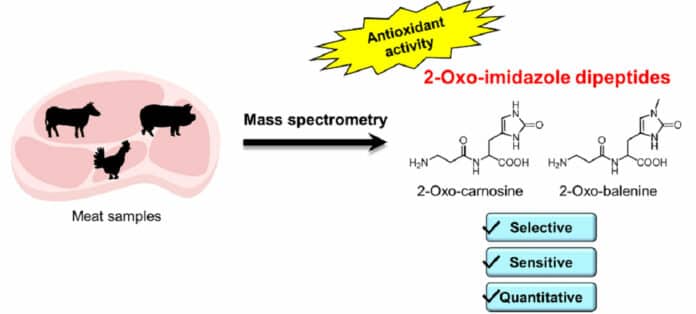2-Oxo-imidazole-containing dipeptides (2-oxo-IDPs), novel imidazole-containing dipeptide (IDP) derivatives, exhibit a much higher antioxidant capacity than that of IDPs. Usually found in meat and fish, these substances are produced in the bodies of various animals, including humans. They have been reported to be effective in relieving fatigue and preventing dementia.
However, the physiological mechanism by which IDPs exhibit these activities had not been determined previously.
A new study by the Osaka Metropolitan University Graduate School of Science discovered that 2-oxo-imidazole-containing dipeptides (2-oxo-IDPs) are the body’s most common variety of IDP derivatives.
2-oxo-IDPs have one more oxygen atom than normal IDPs. They tend to have remarkably high antioxidant activity.
In their study, the researchers established a method for selective and highly sensitive detection of five types of 2-oxo-IDPs using mass spectrometry, which enables quantitative detection of trace 2-oxo-IDPs in living organisms. Using this method, they revealed for the first time that beef, pork, chicken, and other meats contain antioxidants, not only IDPs but a variety of different 2-oxo-IDPs.
Professor Hideshi Ihara from the Osaka Metropolitan University Graduate School of Science said, “We hope that this research method, which enables advanced analysis of 2-oxo-IDPs, will be applied not only to basic biology but also to medicine, agriculture, and pharmacy, where it will help improve peoples’ health and prevent diseases.”
Journal Reference:
- Somei Komae et al. Quantitative Determination of 2-Oxo-Imidazole-Containing Dipeptides by High-Performance Liquid Chromatography/Tandem Mass Spectrometry. Antioxidants 2022. DOI: 10.3390/antiox11122401
